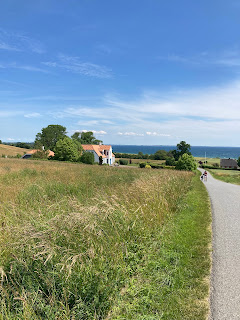Rural Touring
This past week, we biked around Aero and Tasigne island, from Svendborg to Korinth, and Korinth to Ringe. We biked around 75 miles over the course of four days. It was nice to get out of the city and bike around more immersive nature. My favorite part of touring was getting exercise while seeing new places. I think biking is a great way to see the country because it gets your around quickly and keeps you moving. Whenever I am in a new place I always walk everywhere or try to rent a bike. I rented a scooter once in Baltimore, which was fun, but someone who values physical activity, I missed that element. On both of those islands, it would have been impractical to sightsee via a private automobile. Bicycles allow you to explore smaller streets and pedestrian plazas easier. My overall reaction to the four days was surprised about the lack of infrastructure. I was thinking that we were touring because we were going to explore more great bicycle infrastructure, but it wasn't exponentially different than rural cycling at home. We were on a lot of country roads, which were not highly trafficked, with a few opportunities for protected, separated bike lanes. I was thinking that Copenhagen would be reflective of the entire country, but it's not.
Denmark's National Strategy aims to create more recreational cycling routes and promote tourism and active leisure. They list six characteristic's of good cycle routes, safety and security, tourism, service, comfort, signage, and meaningfulness. I appreciated their design comment on safety, stating that a route should not change from a cycle path to a separate layout of a cycle path along a road. The goal is to stay on one consistent type of path. From our experience, I would say that Denmark has a lot of work to do in this realm. Even on Aero island, we switched from a trail path to protected bike lane, to country road. When traveling from Svendborg to Korinth, we had to bike alongside a busy highway that did not have a shoulder. If I was cycling for tourism and wasn't required to be somewhere, I would have turned around. We were able to travel along a new rails to trails path from Korinth to Ringe. Along all of our journeys, there were some examples of great and terrible biking paths. The system is still quite disjointed in the country but they do have pieces. When in Copenhagen, James from Copenhagenize mentioned that building a ped/bike bridge was not very expensive because it connected to already constructed paths. All they had to do was build the connection between two existing networks. I think Denmark needs to identify crucial system connections to expand their cycling tourism.
I decided to take the train with my bike from Ringe to Odense. I was pretty underwhelmed by the train (to me, it's more of a light rail). It cost $9.50 USD for the ticket plus space for the bike. First, there were already bikes so mine barley fit. Second, I was worried it was going to fall over the entire time because there were no racks. No one came to check my ticket. In New Jersey, we have a light rail called the River Line that goes from Camden to Trenton. You can get to the Camden riverfront for concerts, transfer to the PATCO to get to Philadelphia center city, or you can go to Trenton, which connects you to NJ transit, taking you to NYC or the beach, or connecting you to Amtrak. Needless to say, the light rail is a huge connector line and it costs less than $2.00 one way. There are hanging bike racks on the NJ light rail as well. Camden and Trenton are more economically distressed towns and the light rail is a huge investment in supporting transportation between the routes communities. I can't image if that route cost NJ riders $6-9.00 one way. I know that Denmark is coined a wealthy community but I would not travel on that light rail again because of the cost.




You make a really good point about how it's easier to see sights on a bike than walking or in a car! You can cover more territory than walking, but can engage more with the landscape than being inside a car. I resonate with your comments about the variation in rural infrastructure and the need to invest in key connections.
ReplyDelete